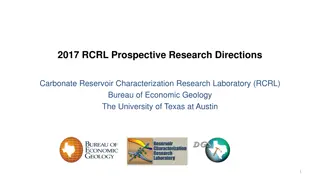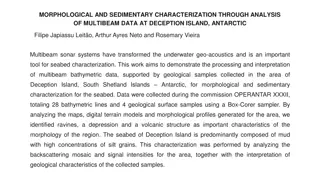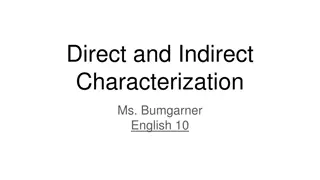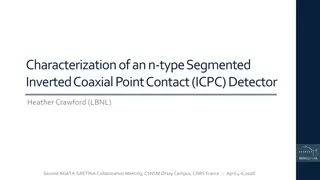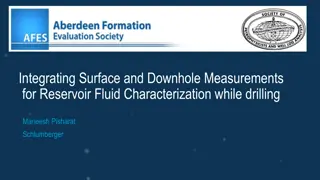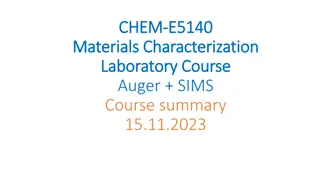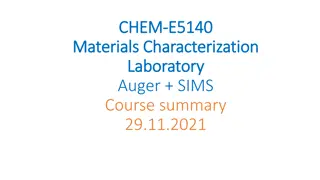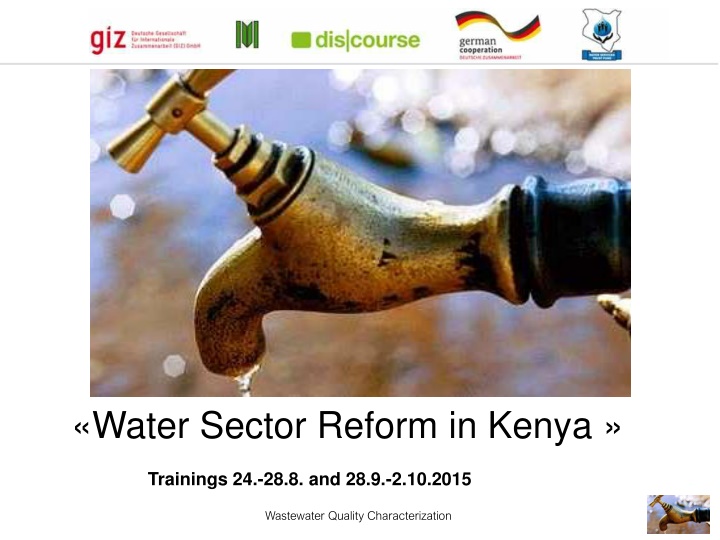
Water Sector Reform in Kenya: Wastewater Quality Characterization
Explore the essential aspects of wastewater quality characterization, including organic parameters like BOD and COD. Discover how wastewater constituents are classified and why monitoring them is crucial for water pollution control and aquatic health in Kenya.
Download Presentation

Please find below an Image/Link to download the presentation.
The content on the website is provided AS IS for your information and personal use only. It may not be sold, licensed, or shared on other websites without obtaining consent from the author. If you encounter any issues during the download, it is possible that the publisher has removed the file from their server.
You are allowed to download the files provided on this website for personal or commercial use, subject to the condition that they are used lawfully. All files are the property of their respective owners.
The content on the website is provided AS IS for your information and personal use only. It may not be sold, licensed, or shared on other websites without obtaining consent from the author.
E N D
Presentation Transcript
Water Sector Reform in Kenya Trainings 24.-28.8. and 28.9.-2.10.2015 Wastewater Quality Characterization
Wastewater Quality Characterization Based on DWA/Engicon Wastewater Quality Characterization , modified by Margraf Publishers Wastewater Quality Characterization
Table of Content Primary organic parameters Biochemical oxygen demand (BOD) Chemical oxygen demand (COD) Solids Oil & grease Detergents Nitrogen Phosphates Heavy metals Pathogens Bacteria Viruses Worms Wastewater Quality Characterization
Wastewater may contain any material which may be dissolved or suspended Wastewater constituents are classified into: Organic Inorganic Wastewater Quality Characterization
Primary organic parameters Organic materials in wastewater is the major concern in the field of water pollution control. The decrease in dissolved oxygen dissolved oxygen due to the process of biodegradation biodegradation is detrimental to the health of the receiving waterways and aquatic life. There are two major tests used to measure organic material in wastewater: Biochemical Oxygen Demand (BOD) Chemical Oxygen Demand (COD) Wastewater Quality Characterization
Biochemical oxygen demand (BOD) BOD is an indirect measurement of biodegradable organic material. The BOD test measures the oxygen depleted after a period of five days in a closed system which contains a mixture of wastewater and an acclimated seed of microorganisms. the amount of oxygen is required to stabilize the biodegradable organic fraction Wastewater Quality Characterization
Chemical oxygen demand (COD) COD is another indirect measurement of organic material. COD is the amount of oxygen consumed by the oxidizable material in wastewater, ie, most of the organic compounds (biodegradable and non-biodegradable) COD measures the oxygen equivalent to the organic material oxidized by dichromate or permanganate during acid digestion. This parameter was developed in order to substitute for the more This parameter was developed in order to substitute for the more time time- -consuming BOD test. consuming BOD test. Wastewater Quality Characterization
Solids Wastewater solids are present in nearly all wastewater discharges. Solids occur in wastewater as a result of storm water runoff, sanitary discharge, chemical and biochemical precipitation reactions in the waste and direct discharge of solid materials. Solids may be organic or inorganic Wastewater solids are classified according to physical properties . The basic types of solids include: settleable solids, suspended solids (TSS), and dissolved solids (TDS). colloids Wastewater Quality Characterization
Oil and grease High grease content can cause clogging of filters, nozzles, and sand beds. Grease can coat the walls of pipes and sedimentation tanks and decompose and increase the amount of scum. If grease is not removed before discharge of the effluent, it can interfere with the biological processes in the surface waters and create unsightly floating matter and films. Wastewater Quality Characterization
Detergents Detergents affect wastewater treatment processes by (1) lowering the surface, or interfacial, tension of water and increase its ability to wet surfaces with which they come in contact; (2) emulsify grease and oil and deflocculate colloids; (3) induce flotation of solids and give rise to foams; (4) may kill useful bacteria and other living organisms. Wastewater Quality Characterization
Nitrogen In wastewater treatment, the nitrogen forms of primary concern are: Ammonia nitrogen (NH3-N) Nitrate nitrogen (NO3-N) Nitrite nitrogen (NO2-N). Wastewater Quality Characterization
Ammonia Nitrogen (NH3-N) as well as organic nitrogen is present in most natural waters in relatively low concentrations low concentrations. Concentrations as low as 0.5 mg/L have been reported to be toxic to some fish and concentrations as high as 1,600 mg/L have proved to be inhibitive to biological waste treatment plant microorganisms. Wastewater Quality Characterization
Nitrate nitrogen (NO3-N) may result from the biological nitrification of ammonia biological nitrification of ammonia to nitrate. Nitrate nitrogen should be restricted from drinking water supplies because it inhibits oxygen transfer in blood If too much nitrate enters the water supply, it produces an overabundance of algae called algal bloom. Wastewater Quality Characterization
Nitrite nitrogen (NO2-N) is most commonly found in treated wastewaters or natural streams at very low concentrations (0.5 mg/L). Nitrite is an inhibitor to the growth of most microorganisms and for this reason is widely used as a food preservative Wastewater Quality Characterization
Phosphates Phosphates are commonly found in industrial and domestic waste streams from sources including corrosion inhibitors, detergents, process chemical reagents, and sanitary wastes. Phosphorus is an essential nutrient in biochemical mechanisms. A residual of 0.5 to 1.0 mg/L total phosphorus is usually required in biological waste treatment systems to ensure efficient waste treatment. Excessive phosphorus in natural waterways, however, can be very harmful resulting in algal blooms and eutrophication Wastewater Quality Characterization
Heavy metals Some of the heavy metals of interest are copper (Cu), chromium (Cr), cadmium (Cd), zinc (Zn), lead (Pb), nickel (Ni), and mercury (Hg). These materials may be measured directly. These elements may be inhibitive or toxic to aquatic organisms and the microorganisms employed in biological waste treatment systems Wastewater Quality Characterization
Pathogens Wastewaters that contain pathogenic bacteria can originate from domestic wastes, hospitals, livestock production, slaughterhouses, tanneries, pharmaceutical manufacturers, and food processing industries. The major pathogens of concern include certain bacteria, viruses, and parasites Wastewater Quality Characterization
Bacteria Gastrointestinal disorders are common symptoms of most diseases transmitted by waterborne pathogenic bacteria. In wastewater treatment processes, bacteria are fundamental, especially in the degradation of organic matter that takes place in activated sludge processes, trickling filters, and biosolids digestion. The coliform group of bacteria has been used to indicate the bacterial pollution of water and wastewater. Generally used test parameters employed as water quality indicators are total coliform and fecal coliform. The total coliform test includes organisms other than those found in the gastrointestinal tracts of mammals. Wastewater Quality Characterization
Common enteric pathogenic bacteria and related disease Bacteria Disease Salmonella typhosa Salmonella paratyphi Salmonella typhimurium Shigella sonnie, S. flexneri Vibrio chlorea Pseudomonas aeruginosa Klebsiella sp. Diplococcus pneumonia Clostridium Botulism Brucella sp. Typhoid fever Paratyphoid fever Salmonellosis Shigellosis Cholera Enteric infection Enteric infection Infectious pneumonia botulinum Brucellosis Wastewater Quality Characterization
Viruses Viruses are submicroscopic obligate parasites which can only replicate in a host cell. Viruses can survive for weeks, even months outside a host cell awaiting the opportunity to re-infect another host. Viruses cause a large number of diseases including the common cold, measles, poliomyelitis, hepatitis, etc. Wastewater Quality Characterization
Worms Worms are the normal inhabitants in organic mud and organic slime. They have aerobic requirements, They can metabolize solid organic matter not readily degraded by other microorganisms. Water contamination may result from human and animal waste that contains worms. Worms pose hazards primarily to those persons who come into direct contact with untreated water. Swimmers in surface water polluted by sewage or storm water runoff from cattle feedlots and sewage plant operators are at particular risk. Wastewater Quality Characterization








